Belt Filter Press
Fully Automated Filter Press System | Continuous Dewatering Filtration Solutions
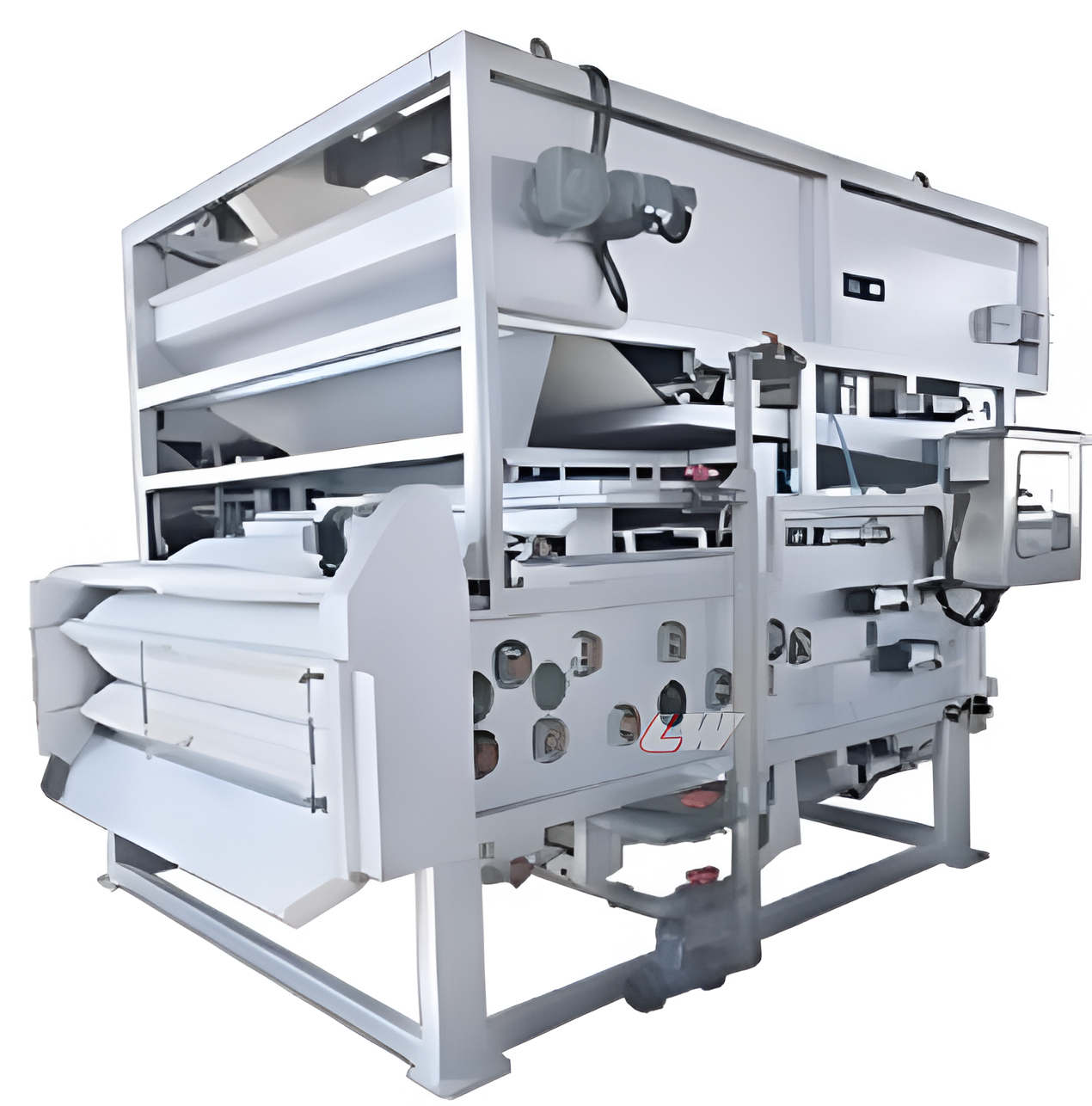
Belt Press Dewatering Machine, is an advanced, continuous solid–liquid separation system engineered to deliver high-performance sludge dewatering in both industrial and municipal applications. Utilizing a dual-belt design—typically composed of high-strength polyester (PET) or polyurethane (PU) monofilament—this machine harnesses gravity drainage and progressive mechanical compression to reduce moisture content and transform sludge or slurry into a semi-dry filter cake.
Constructed from 304 or 316 stainless steel, Loway Belt Filter Press guarantees long-term corrosion resistance and low maintenance in harsh environments.
The skid-mounted frame integrates sludge conditioning, gravity drainage zone, wedge (pre-compression) zone, high-pressure roller zone, cake discharge, and belt cleaning into one compact footprint.
Programmable logic controls (PLC) govern motor speeds, belt tensions, chemical dosing, and wash cycles for fully automated, unattended operation, while optional vibration or ultrasonic sensors monitor belt health and cake consistency.
Key advantages
-
Continuous Operation: Unlike batch systems, the belt press runs 24/7 with stable throughput—ideal for plants with fluctuating sludge loads.
-
Energy Efficiency: Moderate power consumption (15–45 kW) combined with optimized flocculant dosing reduces overall operating costs.
-
High Cake Solids: Achieves 18–30% dry solids under typical conditions; specialty designs exceed 35% for challenging sludges.
-
Scalable Capacity: Models range from 5 m³/h to 150 m³/h (sludge flow), accommodating small municipal plants to large industrial complexes.
-
Eco-Friendly: Minimizes landfill volume, lowers transportation emissions, and recovers water for reuse—supporting circular economy goals.
Ideal for wastewater treatment belt press applications in chemical, petrochemical, pharmaceutical, food & beverage, pulp & paper, mining, and environmental remediation.
Process Workflow
Sludge Feed & Conditioning
Sludge enters via a positive-displacement or peristaltic feed pump, maintaining constant flow. The integrated polymer dosing unit adds cationic or anionic polyacrylamide (PAM) flocculants. A static or dynamic mixer ensures uniform polymer–sludge contact, forming robust flocs that improve dewatering.Gravity Drainage Zone
Flocculated sludge is deposited onto the porous lower belt via a feed distribution box. In this initial zone, gravitational pull allows free water to drain through the belt openings. A suction box may augment drainage for highly turbid sludges.Wedge (Pre-Compression) Zone
The lower and upper belts converge at an adjustable wedge block, gently compressing flocs between belts. This stage expels additional water without overstressing the belts, preserving longevity while raising solids concentration by 20–50%.High-Pressure Roller Compression Zone
Sludge moves through a series of rollers—typically 4 to 7—arranged with descending diameters to deliver progressive, high pneumatic or hydraulic pressure (0.4–1.2 MPa). Water is forced out through both belts into the filtrate tray, collected for recirculation or discharge.Cake Discharge
At the final roller, the dewatered cake (18–30% dry solids) is scraped off by a doctor blade. The cake slides onto a discharge chute or conveyor, ready for transport, drying, or energy recovery.Belt Cleaning & Recycle
Spent belts traverse a wash station with high-pressure nozzles, brush units, and air knives to remove residual fines. Clean belts then re-enter the feed zone for continuous operation.
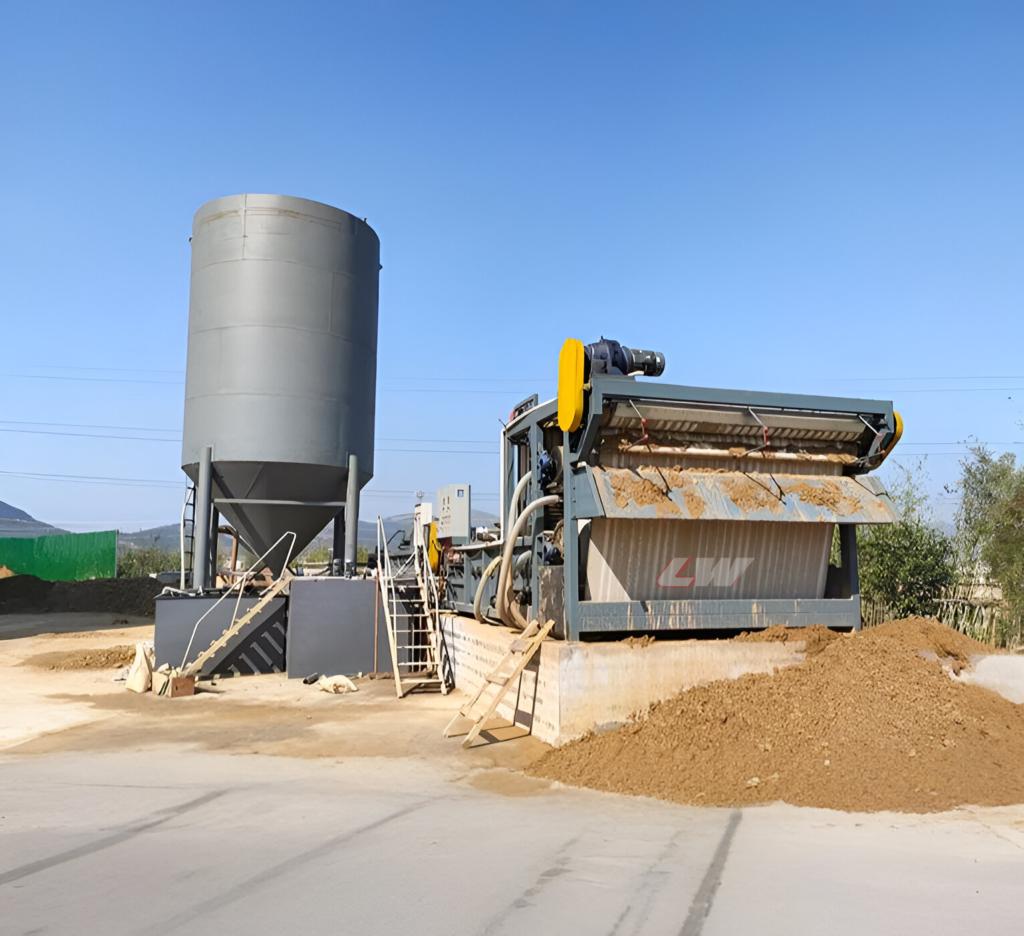
Technical Parameters
Parameters | LWBFP-500 | LWBFP-1000 | LWBFP-1500 | LWBFP-2000 | LWBFP-2500 | LWBFP-3000 | |
Filter Belt Width B (mm) | 500 | 1000 | 1500 | 2000 | 2500 | 3000 | |
Capacity Q (m³/h) | 5 – 10 | 10 – 20 | 20 – 30 | 30 – 40 | 40 – 60 | 60 – 80 | |
Overall Dimensions (W×L×H) | 920×4490×1900 | 1420×4490×1900 | 1920×4490×1900 | 1920×4490×1900 | 2920×4520×1650 | 3420×5520×1650 | |
Filter Belt Running Speed V (mm/min) | 3.0 – 15 (Thickening Section) 1.2 – 6.0 (Dewatering Section) | ||||||
Thickening Motor Power N₁ (kw) | 0.55 | 0.55 | 0.75 | 1.1 | 1.5 | 1.5 | |
Dewatering Motor Power N₂ (kw) | 0.75 | 1.5 | 1.5 | 2.2 | 3 | 5 | |
Discharge Port Height H (mm) | 1250 | 1250 | 1500 | 1500 | 1800 | 1800 | |
Washing Water | Water Consumption (m³/h) | 4 | 7.5 | 12 | 15 | 25 | 30 |
Water Pressure (MPa) | ≥0.5 | ||||||
Compressed Air | Air Consumption (m³/h) | 0.3 | 0.3 | 0.4 | 0.4 | 0.4 | 0.4 |
Air Pressure (MPa) | ≥0.7 | ||||||
Residual/Mixed Sludge | Feed Moisture Content (%) | 99.6/99.0 | |||||
Cake Moisture Content (%) | 80/78 | ||||||
Dry Sludge (Kgds/h·m) | 110 – 130 | ||||||
Hydraulic Load (m³/h·m) | 22 – 26/12 – 16 | ||||||
Installation Dimensions (mm) | H₁ | 700 | 1200 | 1700 | 2200 | 2700 | 3200 |
H₂ | 1120 | 1620 | 2120 | 2620 | 3120 | 3620 | |
H₃ | 1780 | 1280 | 2780 | 3380 | 3380 | 4300 | |
H₄ | 1830 | 1330 | 2830 | 3630 | 4130 | 4630 | |
H₅ | 2380 | 2880 | 3380 | 3880 | 4380 | 4880 | |
Working Principle of belt filter press
The Working Principle of Loway Belt Filter Press combines chemical conditioning, gravity separation, and mechanical compression in a synchronized process:
- Flocculation: Polymer molecules (flocculants) attach to sludge particles, neutralizing charges and linking particles into larger aggregates (flocs).
- Gravity Drainage: The upper and lower belts form a slurry suspension layer; no external pressure is applied beyond the sludge weight. Free water percolates through the lower belt’s pores into a drainage pan.
- Pre-Compression: Controlled wedge pressure initiates dewatering under low stress, removing interstitial water between flocs. This reduces cake height and increases solids concentration for optimal roller compression.
- Roller Compression: A sequenced set of rollers applies mechanical pressure. The belts sandwich the sludge, exerting pressure up to 5 MPa on micro-pore boundaries, squeezing out bound water. Filtrate flows laterally to side trenches and is collected.
- Continuous Belt Movement: Synchronized drives maintain consistent belt speed (typically 1–6 m/min), ensuring uniform residence time. PLC regulates speed based on real-time feedback (sludge feed rate, cake dryness). The closed-loop design yields minimal manual adjustments.
- This robust combination of mechanical dewatering and polymer-enhanced separation makes the belt filter press an economical choice for high-volume sludge streams.
High press & continuous type
Loway belt filter press is an advanced continuous filtration system designed for efficient dewatering of various slurries and sludges.
This innovative equipment combines mechanical dewatering with chemical conditioning to achieve optimal moisture removal from suspended solids.
The belt filter press features dual parallel belts that work in tandem to compress and dewater materials continuously. This continuous operation ensures consistent product quality while maximizing operational efficiency.
The equipment incorporates advanced polymer dosing systems, precise pressure control mechanisms, and automated cleaning cycles to maintain peak performance throughout extended operating periods.
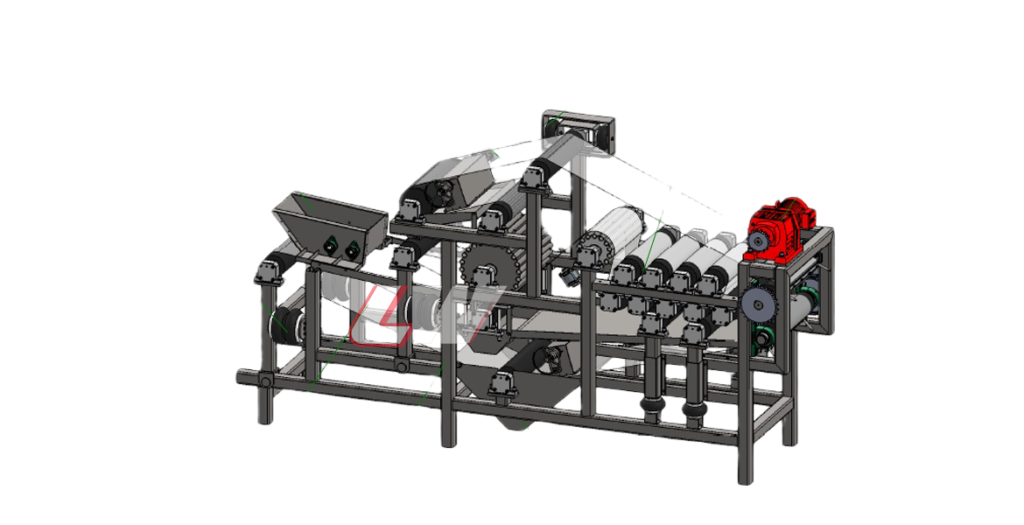
Key Components and Engineering Features
High-Performance Filter Belts | Our premium filter belts utilize advanced synthetic materials engineered for extended service life and superior drainage characteristics. These specialized belts resist chemical degradation, abrasion, and temperature extremes while maintaining consistent permeability throughout their operational lifespan. |
Precision Roller Systems | The compression roller assembly incorporates hardened steel rollers with specialized surface treatments that ensure uniform pressure distribution across the belt width. These precision-engineered components maintain dimensional stability under high loading conditions while minimizing maintenance requirements. |
Advanced Polymer Dosing Systems | Integrated polymer preparation and dosing systems provide precise chemical addition control, optimizing flocculation while minimizing chemical consumption. These automated systems feature real-time flow monitoring and adaptive dosing algorithms that respond to varying feed characteristics. |
Automated Belt Washing Systems | Continuous belt cleaning systems maintain optimal filtration performance by preventing blinding and extending belt service life. These systems incorporate high-pressure wash water systems, chemical cleaning cycles, and automated cleaning sequence controls. |
Pneumatic Tensioning Systems
| Advanced belt tensioning mechanisms maintain optimal belt tension across varying operating conditions, ensuring consistent dewatering performance while preventing premature belt wear. |
PLC Touchscreen Panel | Real-time monitoring; recipe storage; alarms; remote connectivity optional. |
Comparison with Other Filter Press Types

| Feature | Belt Filter Press | Chamber Filter Press | Plate & Frame Press | Screw Press |
| Mode | Continuous | Batch | Batch | Continuous |
| Throughput | High (5–150 m³/h) | Low–Medium (0.2–5 m³/batch) | Medium (1–10 m³/batch) | Low–Medium (1–20 m³/h) |
| Cake Solids | 18–30% (standard); up to 35% | 40–60% | 30–50% | 15–25% |
| Automation | Full PLC control | Manual/semiautomatic | Manual/semiautomatic | Moderate automation |
| Energy Use | Moderate | Low | High | Low |
| Maintenance | Belt replacement (2–5 years) | Cloth & plate cleaning | Plate cleaning & repair | Low (screw wear) |
| Footprint | Moderate to large | Compact | Compact | Medium |
Applications and Usage Range
Belt filter press systems excel in municipal sewage treatment applications, efficiently dewatering activated sludge, primary sludge, and digested biosolids. These systems achieve exceptional solid capture rates while producing a stable, manageable cake suitable for various disposal or beneficial use applications.
- Pulp and Paper Industry: Dewatering paper mill sludges and fiber recovery operations
- Food Processing: Managing organic waste streams and byproduct recovery
- Chemical Manufacturing: Separating catalyst slurries and reaction byproducts
- Pharmaceutical Production: Processing pharmaceutical waste and active ingredient recovery
Belt filter press technology provides efficient tailings dewatering in mining operations, reducing environmental impact while recovering valuable process water. These systems handle high-volume mineral slurries while maintaining consistent separation efficiency across varying ore characteristics.
Environmental cleanup projects utilize belt filter press systems for contaminated soil washing, groundwater treatment, and hazardous waste processing applications.
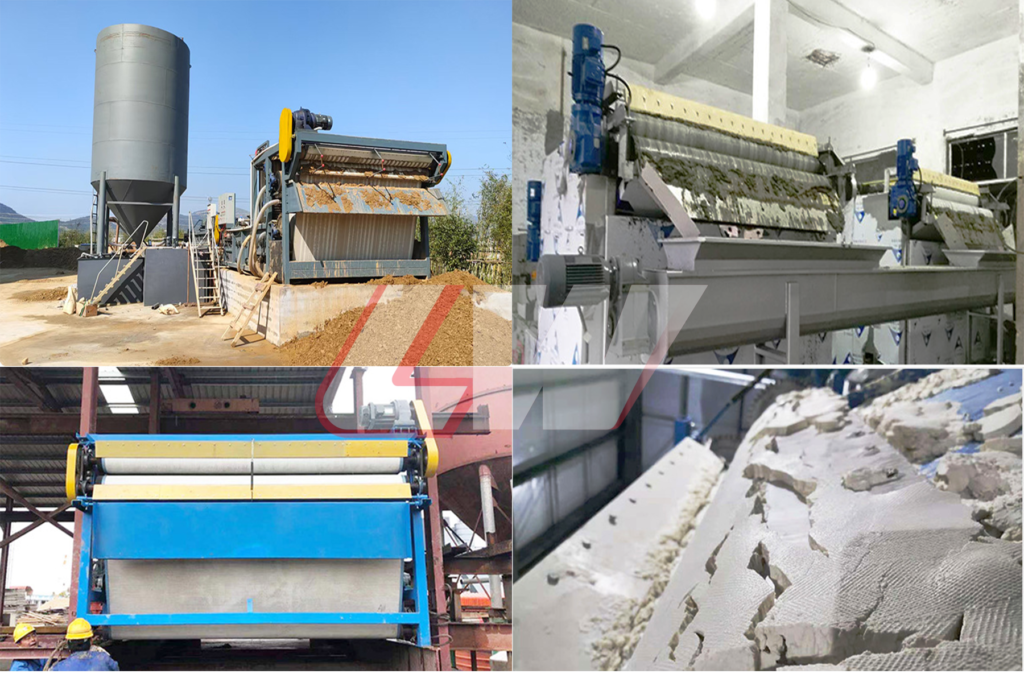
Common Questions
Have More Questions? Our technical team is ready to provide detailed, personalized guidance.
Q1:What sludge concentration is best for the Belt Filter Press?
For optimal performance, feed sludge solids concentration should range between 0.5% and 5% by weight. Ideally, upstream thickening to 2–3% enhances cake dryness and reduces polymer consumption. Jar or shear tests can pinpoint the ideal solids concentration for your feed.
Q2: How do I select belt width and model?
Match your daily sludge volume and peak flow rate to belt capacity. Smaller installations use 500–800 mm belts (5–50 m³/h), while large plants require 1000–1200 mm or even 1500 mm belts (50–150 m³/h+). Factor in floor space, sludge abrasiveness, and desired cake dryness.
Q3: What maintenance of belt filter press is required?
Routine upkeep includes:
Inspecting belt tension and tracking weekly
Cleaning wash nozzles and doctor blades daily
Lubricating bearings monthly
Replacing belts every 2–5 years (depending on wear)
Annual full inspection by certified technicians
Q4: Can the press handle high-temperature sludges?
Standard belts handle up to 60 °C. For temperatures above this, request heat-resistant belts, upgraded seals, and insulated frames.
Q5: Can belt filter press handle varying feed conditions?
Modern belt filter press systems incorporate adaptive control technologies that automatically adjust operational parameters to accommodate varying feed conditions. However, significant changes in feed characteristics may require polymer dosage adjustments or operational modifications.
Q6: What safety considerations apply?
Belt filter press operation requires standard industrial safety protocols including lockout/tagout procedures, confined space entry protocols for maintenance access, and appropriate personal protective equipment. Automated safety systems prevent operation during maintenance activities and protect against mechanical hazards.
Q7: Can the system be automated?
Yes, modern belt filter press systems feature comprehensive automation including automatic startup/shutdown sequences, adaptive process control, remote monitoring capabilities, and integrated maintenance scheduling systems. These automated features reduce labor requirements while optimizing performance consistency.
How it works
We provide one-stop service of solid-liquid seporator planning, design, consultation, construction, equipment manufacturing, installation, commissioning and training. We are involved in complete sets of sludge dewatering projects for various industries.
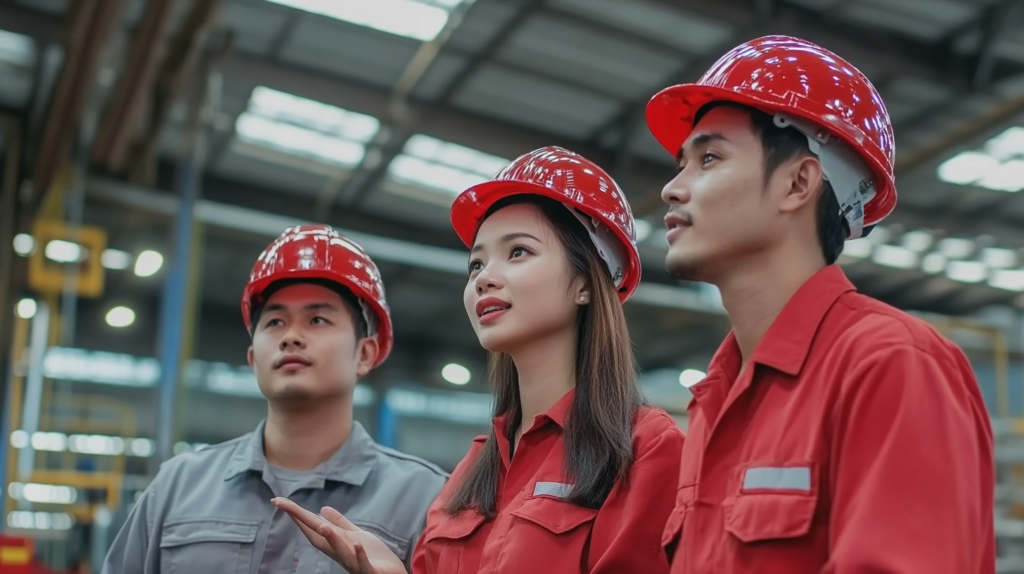
Consultation what you need.
We do not aim to achieve maximum profit and do not reduce the quality of our products by catering to the market with low prices. We are happy to provide high quality tailor-made filtration equipment to you.
Production the filter press equipment for you
Our professional and advanced production technology, excellent manufacturing process, and perfect testing ensure that your equipment fully meets the quality acceptance standards.
Installation and commissioning equipment
Our skilled installation team installs this equipment for you in strict accordance with the construction drawings and construction process steps. Experienced technicians will debug and analyze the average results on site to achieve the best results and meet the needs of use.
After sales service
Our technicians patiently and meticulously answer all your questions and provide guidance and suggestions through messages, phone calls, videos, and arriving at the site.
